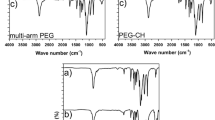Abstract
A comparative analysis of rheological, organoleptic, physical and chemical properties of hydrogels was performed and their biosafety was examined in cell cultures before and after radiation and tyndallization sterilization. It was shown that the radiation sterilization does not destabilize the protein molecules of hydrogels at exposure doses less than 15 kGy, thereby not changing their physical, chemical and biomedical properties and, hence, the operational characteristics of products based on hydrogels.
Similar content being viewed by others
References
M. Widhe, H. Bysell, S. Nystedt, I. Schenning, et al., “Recombinant spider silk as matrices for cell culture,” Biomaterials 31, 9575–9585 (2010).
B. Kundu, N. E. Kurland, V. K. Yadavalli, and S. C. Kundu, “Isolation and processing of silk proteins for biomedical applications,” Int. J. Biol. Macromol. 70, 70–77 (2014).
V. G. Bogush, A. Yu. Sazykin, L. I. Davydova, V. V. Martirosyan, K. V. Sidoruk, A. V. Glazunov, R. I. Akishina, N. A. Shmatchenko, and V. G. Debabov, “Preparation, purification and spinning of recombinant analog of spidroin 1,” Biotekhnologiya 4, 3–12 (2006).
V. G. Bogush, O. S. Sokolova, L. I. Davydova, D. V. Klinov, K. V. Sidoruk, N. G. Esipova, T.V.Neretina, I. A. Orchanskyi, V. Yu. Makeev, V. G. Tumanyan, K. V. Shayjtan, V. G. Debabov, and M. P. Kirpichnikov, “A novel model system for design of biomaterials, based on recombinant analogs of spider silk protein,” J. Neuroimmune Pharmacol. 4 (1), 17–27 (2009).
V. G. Bogush, L. I. Davydova, M. M. Moisenovich, K.V. Sidoruk, A. Yu. Arkhipova, D. G. Kozlov, I. I. Agapov, M. P. Kirpichnikov, and V. G. Debabov, “Biodegradable microand macro cellular carriers on the basis of recombinant spidroin,” Biotekhnologiya, No. 1, 52–61 (2014).
M. J. Garle, J. H. Fentem, and J. R. Fry, “In vitro cytotoxicity tests for the prediction of acute toxicity in vivo,” Toxicol. In Vitro 8, 1303–1313 (1994).
Yu. K. Abaev, Surgeon Directory. Wounds and Wound Infections (Feniks, Rostov-on-Don, 2006) [in Russian].
GOST (State Standard) 29188.0–91: Articles of perfumery and cosmetics. Acceptance rules, sampling and methods of organoleptic tests (1991).
M. Zholi, Physical Chemistry. Protein Denaturation (Mir, Moscow, 1968) [in Russian].
Author information
Authors and Affiliations
Corresponding author
Additional information
Original Russian Text © O.A. Legon’kova, I.P. Savchenkova, M.S. Belova, A.I. Korotaeva, L.I. Davydova, V.G. Bogush, 2016, published in Vse Materialy. Entsiklopedicheskii Spravochnik, 2016, No. 1, pp. 38–43.
Rights and permissions
About this article
Cite this article
Legon’kova, O.A., Savchenkova, I.P., Belova, M.S. et al. A study of biomedical properties of hydrogels based on recombinant spidroin after their sterilization. Polym. Sci. Ser. D 9, 219–222 (2016). https://doi.org/10.1134/S199542121602012X
Received:
Published:
Issue Date:
DOI: https://doi.org/10.1134/S199542121602012X




